Electric Power System Operation Mechanism with Energy Routers Based on QoS Index under Blockchain Architecture
Abstract
1. Introduction
- For the flexible output power generation, synchronizing the demand response and transmission and distribution network characteristics, the doubly-fed stability control model using energy routers nodes under blockchain node topology was designed with the QoS (quality of service) index for the energy flow control. This will help to achieve the optimization of the source side and grid side cooperation.
- The influencing factors of high integration of renewable, network fault or overloading parameters can affect the power generation. Thus, all the influencing factors are considered for generation control feedback and integration control of energy flow and information flow in the transmission, and a distribution network under a weakly centralized scheduling is realized through the b2u (bottom-up) negotiation mechanism based on a master-slave multichain. This will lead to autonomous decision-making capability, and autonomous coordination of transmission and distribution networks will be realized.
- The energy router is used as a network node, and the master-slave multichain negotiation mechanism is used to realize the information exchange between the energy routers, which improves the interoperability between the energy nodes with increased security of blockchain architecture; through the optimization algorithm of the blockchain smart contract, joint output schemes of different power plants can be obtained, which improves the ability of the power transmission and distribution network to mitigate wind and light loss.
2. The Energy Router Operating Scenario with Highly Permeable Renewable Energy Access
2.1. Prerequisites of Weakly Centralized Collaborative Scheduling
- Real-time Monitoring and early warning: It acquires the check result data, such as power generation plan, heavy load, over the limit, sensitivity and other information, to realize real-time monitoring and early warning on both sides of the source and the load, and ensure the safety of the power grid.
- Dispatching plan: It obtains real-time information, such as grid topology trends, which is used to provide source-load prediction data and power generation plans, locate substation authority and perform safety analysis and evaluation of power generation plans.
- Security check: It provides heavy-duty, over-limit, sensitivity, and stability information to review synergistic results on the distribution side.
- Dispatch management: It provides various online equipment parameters of the power system, coordinates and manages the internal function allocation of the dispatch control system.
2.2. Application Scenario of Energy Router Based on Blockchain under “Source–Grid–Load” Cooperative Operation
- Source side: The source side strives to increase the proportion of renewable energy output and reduce the impact of its output fluctuations. It obeys the following principles: (1) priority to maximum utilization of renewable energy; (2) reduce losses caused by “abandonment of wind and solar”; (3) ensure that the electric power system has least disturbances; (4) meet the renewable energy output; and (5) satisfy the corresponding line transmission capacity to the reliable extent.
- Grid side: Grid side is based on the principle that the energy routers at each voltage level are interconnected, and the energy flow and information flow are highly integrated. Due to the diversity of renewable energy forms, the following issues must be kept in full consideration when encouraging the grid to actively access renewable energy: (1) Accessible renewable energy capacity and geographical differences. (2) The particularities of and complementarity between different energy forms. (3) Time sensitivity of renewable energy and volatility of energy supply. Therefore, the energy router not only needs to share some functions of the dispatch control system [26], but also needs to optimize the QoS indicators of the energy nodes of the local level for maintaining the output level of the local renewable energy. Simultaneously, in order to ensure that the energy router can access data at any time and participate in data interaction, record management, etc., to achieve peer-to-peer power demand negotiation in a trusted environment, energy routers at different voltage levels are to be used as network nodes to build different types of energy router negotiation chains to complete energy demand negotiation; authenticating and registering [27]; storing and managing an energy router’s intelligent optimization algorithms and QoS indicator data in a smart contract; and building a weakly centralized trusted transmission and distribution environment. In addition, through the analysis of the previous block data, it can guide the next stage of energy complementary allocation and the formation of transmission and distribution plans [28,29,30].
3. Energy Router Node Model Based on Energy Flow QoS Index and Blockchain Architecture
- The physical node adopts the different types of automatic controllers compatible with various power generation units, such as a power system stabilizer (PSS), an automatic generation controller (AGC), a maximum power point tracker (MPPT) and a droop control, as shown in Figure 2, and forms a doubly-fed stability control model with the energy router to optimize local energy output. The automatic controllers constitute primary feedback by physical means, such as suppressing low-frequency oscillation and initially enhancing the safety of the transmission and distribution network. In order to further improve the interconnection of energy nodes, energy routers (R1–R4 in Figure 2.) are introduced into the transmission lines of different local power plants [31]. In the transmission and distribution network, the energy router can not only realize the interconnection and energy centralized management of different levels of energy nodes but also the function of local distributed power flow information feedback. The energy router integrates the power supply and demand information shared by the upper and lower energy routers, and then negotiates the prediction result through the blockchain, and feeds it back to the local energy power generation units as secondary feedback, further enhancing the output controllability and output stability.
- The blockchain negotiation layer is divided into two types: primary (main) chain and secondary (slave) chain, which jointly achieves the negotiation of power supply and demand between nodes at different voltage levels. The secondary negotiation chain at low voltage level consists of blocks generated by the 35 kV/110 kV/220 kV energy router nodes respectively, which have the function of calculating and recording energy node data, such as the QoS index value of its current level, and the optimal distribution of power transmission and transformation. Those chains also have the function of sharing power information with the negotiation chains at the adjacent voltage level. The blocks generated by the 330 kV energy router nodes constitute the primary negotiation chain at a high voltage level. In addition to implementing the secondary negotiation chain functions, it also has the functions of publishing the negotiation result, calculating the overall QoS index value of the system, storing the negotiation data and recording the expected output value for the source side from the dispatch control system.
- QoS index layer is an evaluation system layer coupled with the optimization strategy. With renewable energy sources with fluctuating output power to further share the load demand, and in order to ensure the quality of power transmission under the requirements of power balance between renewable energy and traditional power generations, it is necessary to refer to the existing information flow transmission QoS indicators to construct an energy node QoS evaluation system that matches the physical node layer. Based on this, the equalization coefficient, line loading rate, loss and loss-to-loss ratio are defined as optimization indicators of the QoS evaluation system. It can provide clear optimization targets for energy router nodes, reduce power transmission loss and improve renewable energy utilization under the condition of ensuring the balanced output of different power generation units.
4. Definition and Evaluation Mechanism of the QoS Index Layer
- (a)
- Equilibrium coefficient: The local renewable energy power generation needs to control its own power generation according to its own weight and the transmission capacity limit Plim. The is defined as the ratio of the predicted output of different renewable energy power generation to the predicted total output of local energy, as shown in Equation (1):where Pi is the predicted output of different energy power plants and NRe is the collection of local power generations of different energy types.
- (b)
- Line loading rate: In order to minimize the energy loss caused by the overhead transmission line and promote the economic operation of transmission and distribution network, the line loading rate is defined as the ratio of actual transmission capacity to transmission capacity limit given by Equation (3).
- (c)
- Degree of loss: Combined with the electric energy surplus of the local wind and solar renewable energy power generations, the degree of loss (Q) is defined as the degree of abandoned wind and solar, which is related to the power loss and the duration of wind and solar abandonment. Degree of loss can be defined by the following Equations (4) and (5):
- (d)
- Input-loss ratio (ILR): The energy loss generated by the substation during the transformation process occupies a considerable proportion of the total loss. The ILR is defined by Equation (6).
5. Blockchain-Based Transmission and Distribution Network Negotiation Model
5.1. Blockchain Hierarchical Negotiation Mapping Architecture
- (a)
- The goal of the application layer is to ensure the quality of power transmission and improve the utilization of renewable energy.
- (b)
- Energy routers at all levels compete for QoS indicators through a consensus layer, the obtained QoS score can form an incentive.
- (c)
- Through the multiobjective intelligent optimization algorithm in the counterparty layer, the optimal output prediction of various energy power generations in the node layer in Figure 2 can be obtained.
- (d)
- By defining the low voltage level negotiation slave chain and the high voltage level negotiation main chain, a master-slave multichain structure is formed to optimize the data dissemination mechanism at the network layer.
- (e)
- The size of the internal block of the master-slave multichain in the data layer is determined by the energy router nodes at different voltage levels, and the block with larger capacity is generated and processed at a slower speed.
5.2. Transmission and Distribution Network Negotiation Mechanism Based on the Master-Slave Multichain Structure
- (a)
- Energy supply and demand negotiation mechanism b2u based on master-slave and multichain.
- Starting at time t, the 35 kV energy router slave chain collects the load current reverse power value PREV and the load predicted value PLP, and calculates the total power required PL at the load side. Combined with the local output predicted value Plocal(35kV), the Pin(35kV) is calculated and uploaded to the 110 kV energy router slave chain by the 35 kV slave chain. This step takes time Δt. Where Pin(35kV) is the power value required by the 35 kV energy router, which is obtained from the 110 kV energy router:
- Starting at time t + Δt, the 110 kV energy router slave chain derives the Pin(110kV) according to Pin(35kV) and Plocal(110kV), and then uploads the data to the 220 kV energy router slave chain before time t + 2Δt. Plocal110kV is the predicted value of the local output and Pin110kV is the value of the power that the 110 kV energy router needs to obtain from the upper 220 kV energy router. Starting at time t + 2Δt, the 220 kV energy router slave chain performs the same steps as the 110 kV energy router slave chain, ending at time t + 3Δt.
- Energy routers’ slave chains at all levels meet the constraints of equalization coefficient and line loading rate respectively, and calculate the amount of renewable energy abandonment Qloss(xkV) and the input loss ratio ILR(xkV) according to their own power calculation. Then, these data are uploaded to the 330 kV energy router main chain within the limit of the data upload time node. As shown in Figure 4, t + Δt, t + 2Δt and t + 3Δt represent the time node.
- Starting at time (t + 3Δt), the 330 kV energy router main chain obtains data Pin(220kV), which is the predicted value of the source power generation demand Pb2u derived by the power negotiation mechanism b2u.
- (b)
- At time t + 4Δt, the 330 kV energy router main chain compares Pb2u with PE, and checks whether Qloss(tatal) and ILR(total) met the requirements of the previous preset values or not.
- (c)
- At time t + 5Δt, the 330 kV energy router’s main chain delivers the results to the energy routers’ slave chains at all levels, and executes negotiation results. Simultaneously, the hash value generated by the result is stored in the main chain block of the 330 kV energy router. This can ensure that the problem caused by the unreasonable negotiation mechanism can be traced back to the source. This step ends at time t + 6Δt.
6. Feasibility Verification
6.1. Simulation of Intelligent Contract Example and Evaluation of QoS Index Based on Multiobjective Particle Swarm Optimization
6.2. Simulation of a Master-Slave, Multichain Negotiation Mechanism Based on a Multichain Platform
7. Conclusions
Author Contributions
Funding
Conflicts of Interest
Nomenclature
| b2u | Bottom-to-up power negotiation mechanism |
| CPS | Cyber-Physical Systems |
| MOPSO | Multiobjective particle swarm optimization |
| MPPT | Maximum power point tracking |
| PSS | Power system stabilizer |
| QoS | Quality of service |
| Plim | Transmission capacity limit |
| i | Equilibrium coefficient |
| Pi | The predicted power output of various types of power generations |
| The actual power delivery capacity of the local distributed renewable generations | |
| NRe | The collection of various types of local power generations |
| φw | Rate of transmission line loading |
| Qloss | Degree of power loss |
| ΔT | Duration of wind and solar abandonment |
| ILR | Input loss ratio |
| Ploss | The energy loss during the substation process of the corresponding grade energy node |
| Pinput | The total energy received by the upper node |
| t | Time at which negotiation mechanism starts execution |
| Δt | Time required to perform each step |
| Plocal (x kV) | Local predicted power output of the energy nodes at all levels |
| Preal (x kV) | Total actual power output |
| Pthermal | Actual power output of the thermal power plant |
| Pin (x kV) | Required power output of 35 kV energy router |
| PREV | Load current grid connected back feed power value |
| PLP | Predicted Load value |
| PL | Total power required at the load side |
| PE | The expected value of the dispatch control system to the source power generation in short term |
Appendix A
| Computational Times | Computational Cost (Seconds) | Computational Results (Thermal; Wind; PV; Hydro) (MW) |
|---|---|---|
| 1 | 196.997661 | 586; 355; 296; 260 |
| 2 | 204.400184 | 558; 377; 302; 259 |
| 3 | 201.155895 | 586; 355; 296; 260 |
| 4 | 191.935027 | 558; 377; 302; 259 |
| 5 | 188.888183 | 561; 376; 300; 260 |
| 6 | 199.140892 | 556; 379; 299; 264 |
| 7 | 198.745108 | 586; 355; 296; 260 |
| 8 | 199.980375 | 557; 376; 300; 260 |
| 9 | 191.858195 | 557; 379; 299; 265 |
| 10 | 200.698211 | 563; 379; 294; 260 |
| Hardware System | Requirements | Others |
|---|---|---|
| Linux | supports Ubuntu 12.04+, CentOS 6.2+, Debian 7+, Fedora 15+, RHEL 6.2+. | 512 MB of RAM 1 GB of disk space |
| Windows | supports Windows 7, 8, 10, Server 2008 or later. | 512 MB of RAM 1 GB of disk space |
| Mac | 64-bit, supports OS X 10.12 | 512 MB of RAM 1 GB of disk space |
Appendix B
Appendix B.1. Establishment of Multichain Nodes
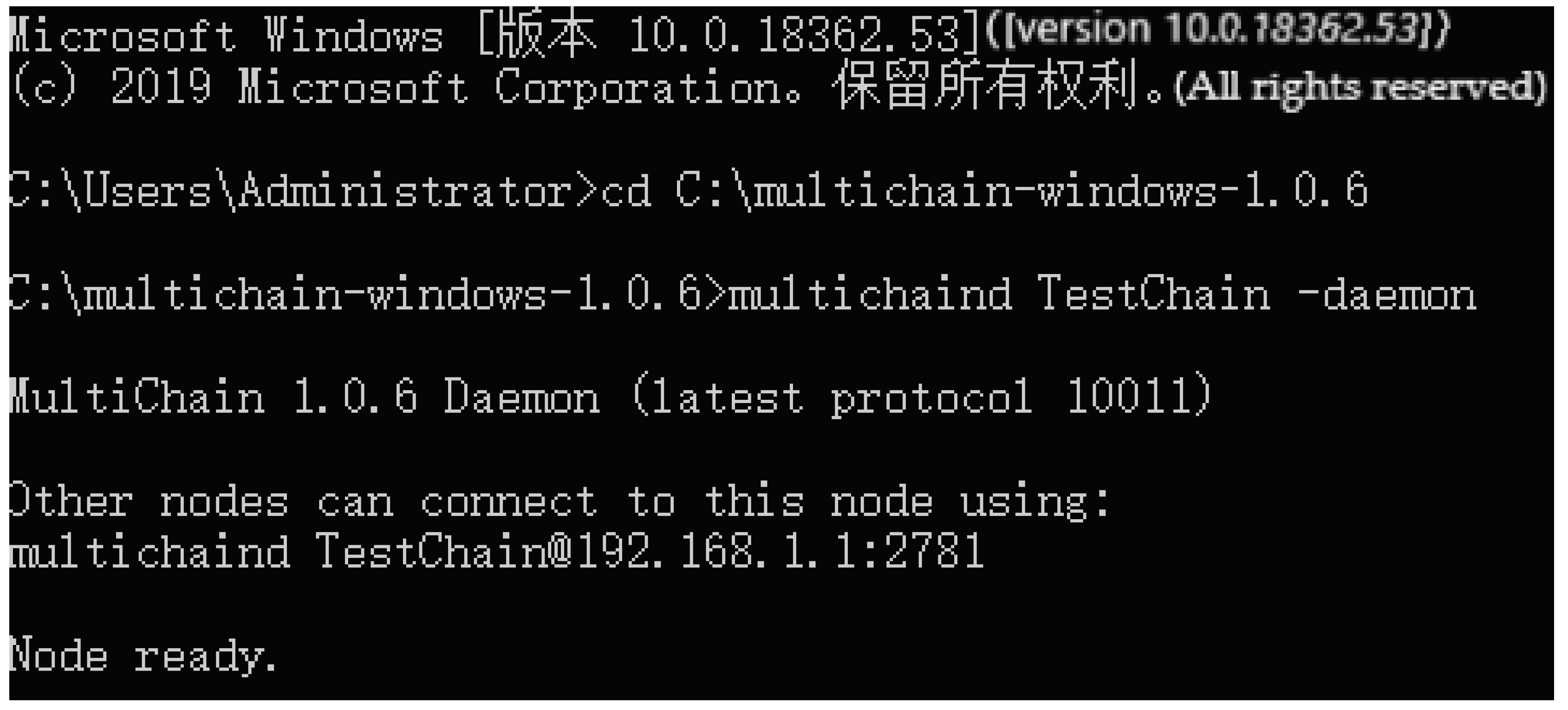
Appendix B.2. The Slave Node Sending a Connection Request to the Primary Node

Appendix B.3. The Master Node Accepting the Application and Setting the Slave Node Permissions

Appendix C
Appendix C.1. Chain330kV, Chain220kV, Chain110kV, and Chain35kV Connection Display (Multichain Connection Display)
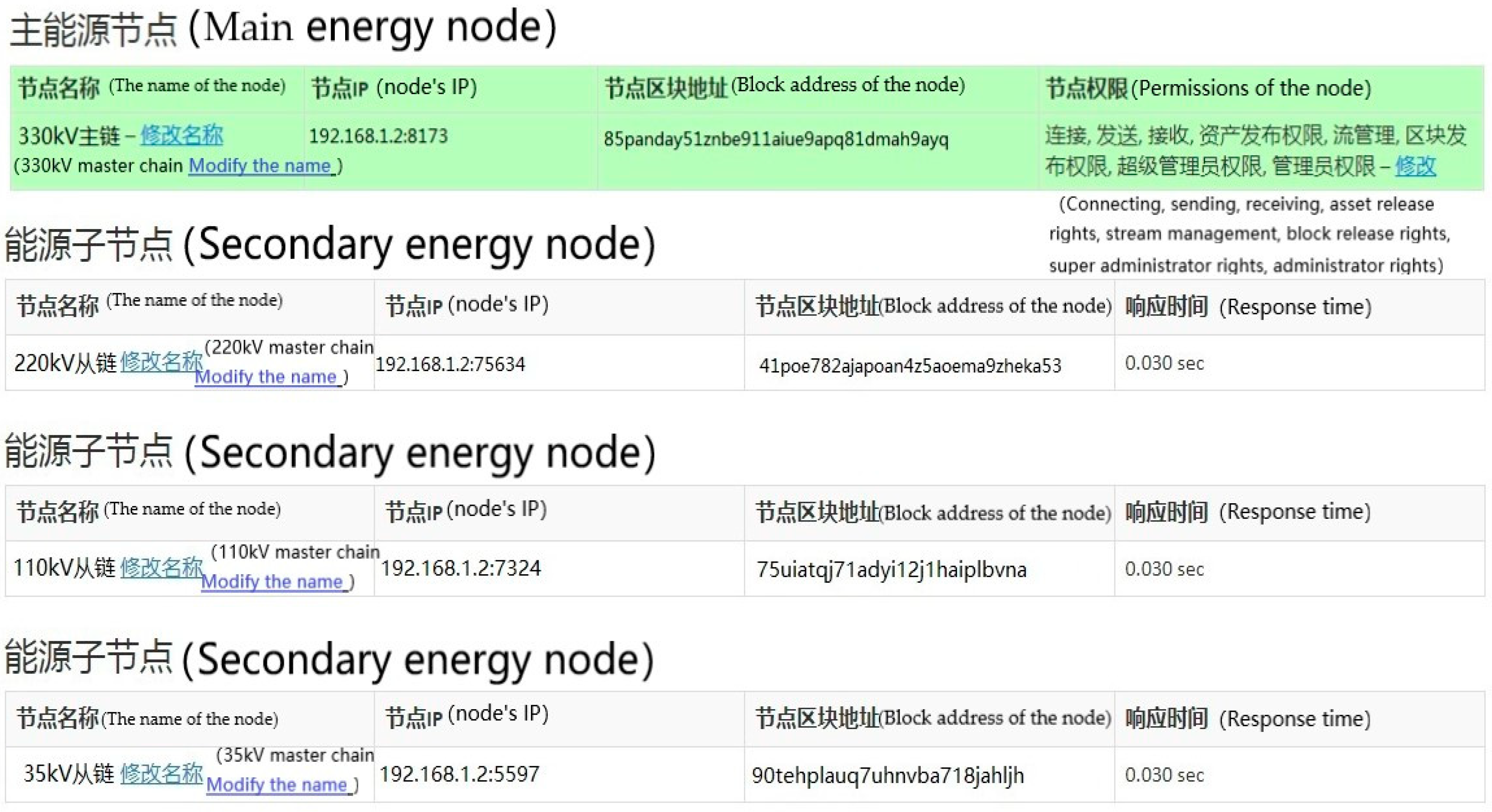
Appendix C.2. Chain35kV’s Scheduling Data Upload and Chain11kV Receiving
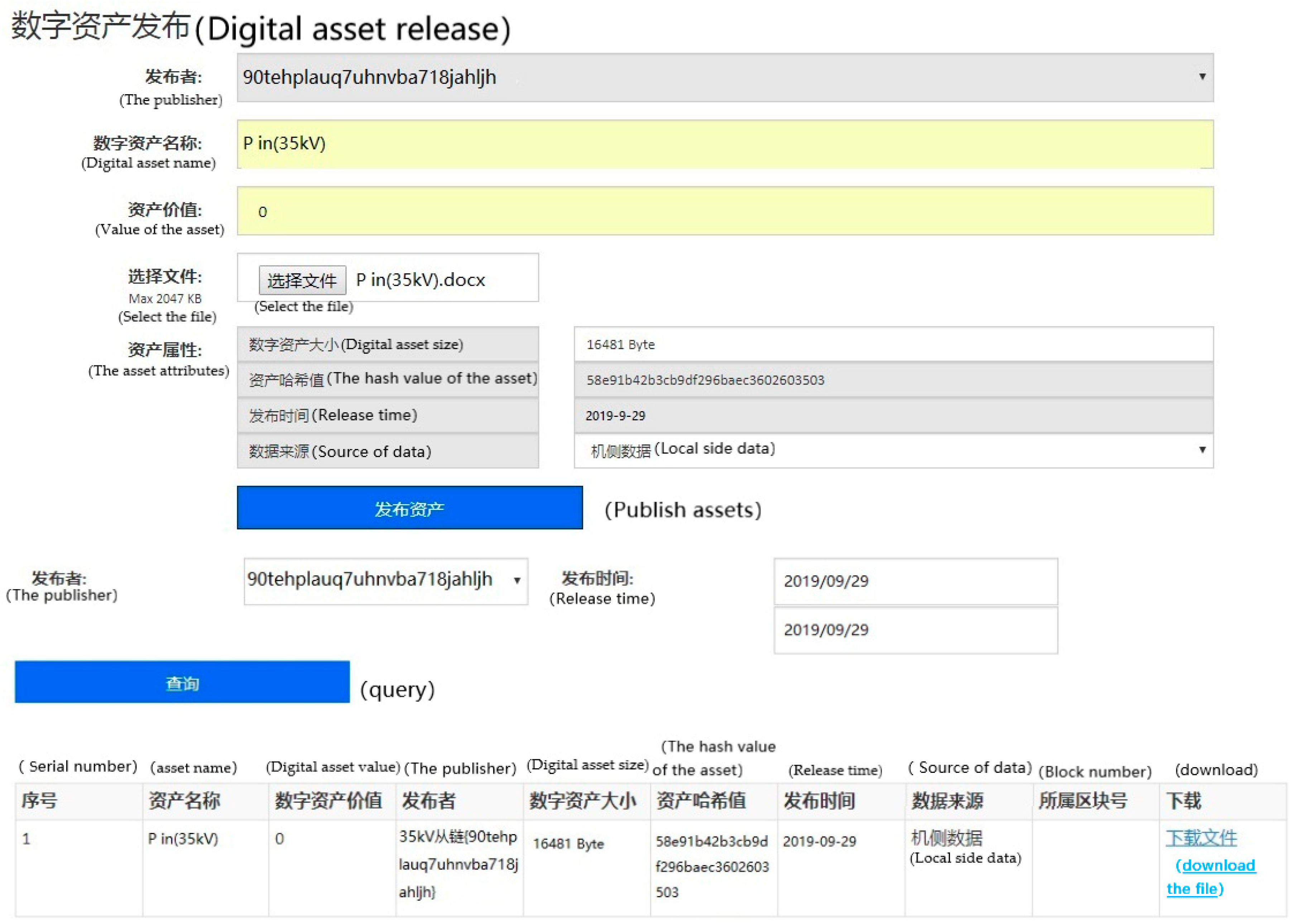
Appendix C.3. Chain110kV’s Scheduling Data Upload, and Chain330kV Receiving Data
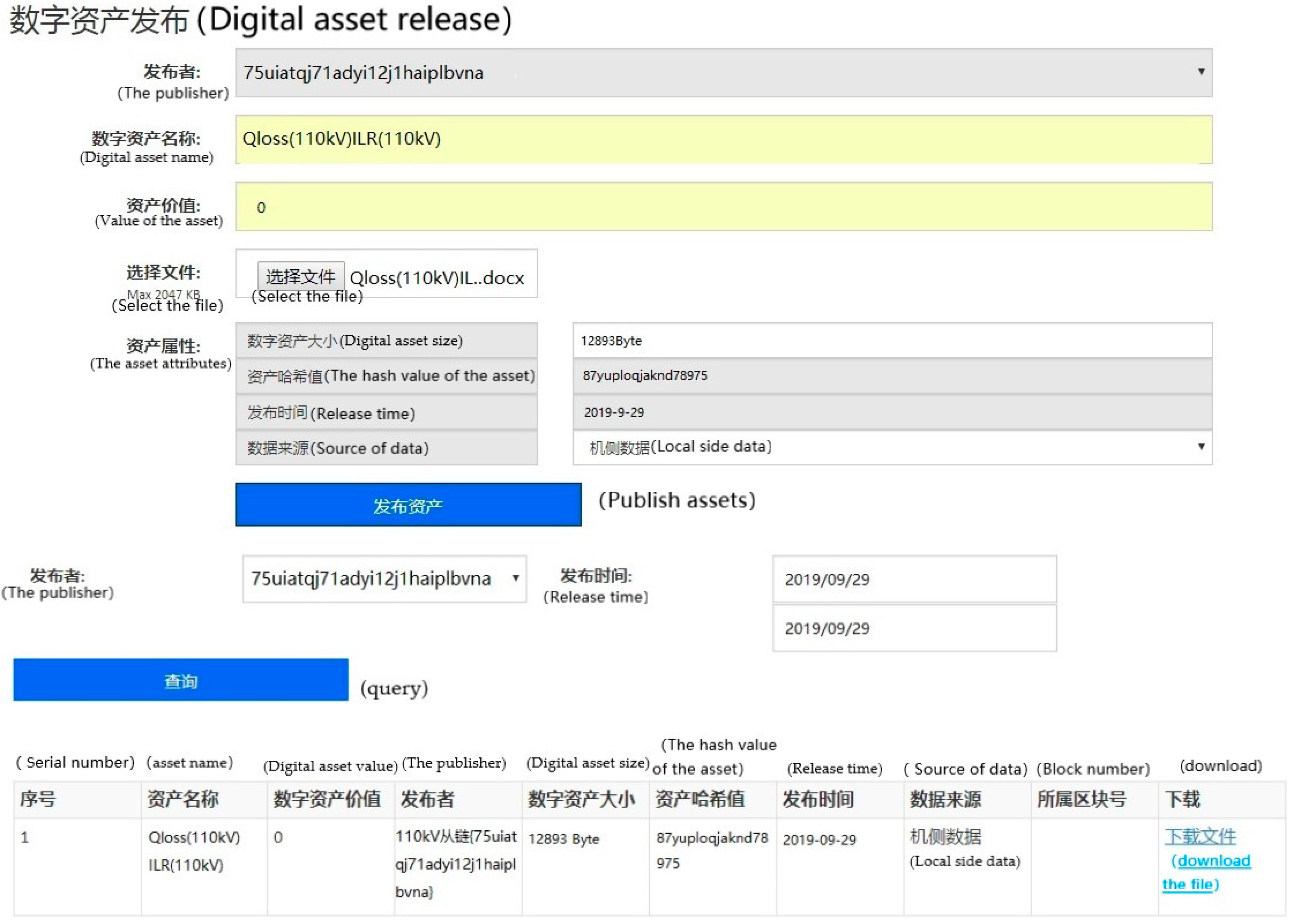
References
- Lo, K. Governing China’s Clean Energy Transition: Policy Reforms, Flexible Implementation and the Need for Empirical Investigation. Energies 2015, 8, 13255–13264. [Google Scholar] [CrossRef]
- Abbott, D. Keeping the Energy Debate Clean: How Do We Supply the World’s Energy Needs? Proc. IEEE 2010, 98, 42–66. [Google Scholar] [CrossRef]
- Elani, U.A.; Alawaji, S.H.; Hasnain, S.M. The role of renewable energy in energy management and conservation. Renew. Energy 1996, 9, 1203–1206. [Google Scholar] [CrossRef]
- Momete, D.C. Analysis of the Potential of Clean Energy Deployment in the European Union. IEEE Access 2018, 6, 54811–54822. [Google Scholar] [CrossRef]
- Nathwani, J.; Kammen, D.M. Affordable Energy for Humanity: A Global Movement to Support Universal Clean Energy Access. Proc. IEEE 2019, 107, 1780–1789. [Google Scholar] [CrossRef]
- Esch, J. Prolog to Keeping the Energy Debate Clean: How Do We Supply the World’s Energy Needs? Proc. IEEE 2010, 98, 39–41. [Google Scholar] [CrossRef]
- Wai, R.-J.; Lin, C.-Y. Dual Active Low-Frequency Ripple Control for Clean-Energy Power-Conditioning Mechanism. IEEE Trans. Ind. Electron. 2011, 58, 5172–5185. [Google Scholar]
- Peñalvo-López, E.; Pérez-Navarro, Á.; Hurtado, E.; Cárcel-Carrasco, F.J. Comprehensive Methodology for Sustainable Power Supply in Emerging Countries. Sustainability 2019, 11, 5398. [Google Scholar] [CrossRef]
- Glensk, B.; Madlener, R. Energiewende @ Risk: On the Continuation of Renewable Power Generation at the End of Public Policy Support. Energies 2019, 12, 3616. [Google Scholar] [CrossRef]
- Abdella, J.; Shuaib, K. Peer to Peer Distributed Energy Trading in Smart Grids: A Survey. Energies 2018, 11, 1560. [Google Scholar] [CrossRef]
- AlSkaif, T.; van Leeuwen, G. Decentralized Optimal Power Flow in Distribution Networks Using Blockchain. In Proceedings of the IEEE 2019 International Conference on Smart Energy Systems and Technologies (SEST), Porto, Portugal, 9–11 September 2019; pp. 1–6. [Google Scholar]
- Kim, G.; Park, J.; Ryou, J. A Study on Utilization of Blockchain for Electricity Trading in Microgrid. In Proceedings of the IEEE 2018 International Conference on Big Data and Smart Computing (BigComp), Shanghai, China, 15–17 January 2018; pp. 743–746. [Google Scholar]
- Wu, J.; Tran, N. Application of Blockchain Technology in Sustainable Energy Systems: An Overview. Sustainability 2018, 10, 3067. [Google Scholar] [CrossRef]
- Chen, X.; Hu, X.; Li, Y.; Gao, X.; Li, D. A Blockchain Based Access Authentication Scheme of Energy Internet. In Proceedings of the 2018 2nd IEEE Conference on Energy Internet and Energy System Integration (EI2), Beijing, China, 20–22 October 2018; pp. 1–9. [Google Scholar]
- Sun, X.; Chen, M.; Zhu, Y.; Li, T. Research on the Application of Blockchain Technology in Energy Internet. In Proceedings of the 2018 2nd IEEE Conference on Energy Internet and Energy System Integration (EI2), Beijing, China, 20–22 October 2018; pp. 1–6. [Google Scholar]
- Zhang, N.; Yi, W.; Chongqing, K.; Jiannan, C.; Dawei, H. Blockchain technology in energy Internet: Research framework and typical application. Chin. J. Electr. Eng. 2016, 36, 4011–4023. [Google Scholar]
- Zhifang, Z.; Haiwang, Z.; Qing, X.; Yang, B. Research review and prospect of transmission network structure optimization. Chin. J. Electr. Eng. 2016, 36, 426–434. [Google Scholar]
- Jinhui, Z.; Yixin, Y.; Yuan, Z. Heuristic optimization algorithm for large-scale wind power transmission network expansion planning. Autom. Power Syst. 2011, 35, 66–70. [Google Scholar]
- Hongzhan, N.; Ying, Z.; Jianbo, M. Emergency demand side response and robust optimization of transmission network planning when wind power is connected to the grid. New Technol. Electr. Power 2015, 35, 7–11. [Google Scholar]
- Pop, C.; Cioara, T.; Antal, M.; Anghel, I.; Salomie, I.; Bertoncini, M. Blockchain Based Decentralized Management of Demand Response Programs in Smart Energy Grids. Sensors 2018, 18, 162. [Google Scholar] [CrossRef]
- Panarello, A.; Tapas, N.; Merlino, G.; Longo, F.; Puliafito, A. Blockchain and IoT Integration: A Systematic Survey. Sensors 2018, 18, 2575. [Google Scholar] [CrossRef] [PubMed]
- Yin, S.; Bao, J.; Zhang, Y.; Huang, X. M2M Security Technology of CPS Based on Blockchains. Symmetry 2017, 9, 193. [Google Scholar] [CrossRef]
- Kim, S.-K.; Huh, J.-H. A Study on the Improvement of Smart Grid Security Performance and Blockchain Smart Grid Perspective. Energies 2018, 11, 1973. [Google Scholar] [CrossRef]
- Ma, Y.; Liu, H.; Zhou, X.; Gao, Z. An Overview on Energy Router Toward Energy Internet. In Proceedings of the 2018 IEEE International Conference on Mechatronics and Automation (ICMA), Changchun, China, 5–8 August 2018; pp. 259–263. [Google Scholar]
- Yang, T.; Guo, Q.; Tai, X.; Sun, H.; Zhang, B.; Zhao, W.; Lin, C. Applying blockchain technology to decentralized operation in future energy internet. In Proceedings of the 2017 IEEE Conference on Energy Internet and Energy System Integration (EI2), Beijing, China, 26–28 November 2017; pp. 1–5. [Google Scholar]
- Kobrle, P.; Kostal, T.; Zednik, J.; Pavelka, J.; Yang, X. Task of Energy Router in Smart Grids. In Proceedings of the IEEE 2018 10th International Conference on Electronics, Computers and Artificial Intelligence (ECAI), Iasi, Romania, 28–30 June 2018; pp. 1–6. [Google Scholar]
- Yu, Y.; Liang, R.; Xu, J. A Scalable and Extensible Blockchain Architecture. In Proceedings of the 2018 IEEE International Conference on Data Mining Workshops (ICDMW), Singapore, 17–20 November 2018; pp. 161–163. [Google Scholar]
- Qiao, K.; Tang, H.; You, W.; Zhao, Y. Blockchain Privacy Protection Scheme Based on Aggregate Signature. In Proceedings of the 2019 IEEE 4th International Conference on Cloud Computing and Big Data Analysis (ICCCBDA), Chengdu, China, 12–15 April 2019; pp. 492–497. [Google Scholar]
- Ding, X.; Yang, J. An Access Control Model and Its Application in Blockchain. In Proceedings of the IEEE 2019 International Conference on Communications, Information System and Computer Engineering (CISCE), Haikou, China, 5–7 July 2019; pp. 163–167. [Google Scholar]
- Bahri, L.; Girdzijauskas, S. Blockchain Technology: Practical P2P Computing (Tutorial). In Proceedings of the 2019 IEEE 4th International Workshops on Foundations and Applications of Self* Systems (FAS*W), Umea, Sweden, 16–20 June 2019; pp. 249–250. [Google Scholar]
- Zhou, X.; Wang, F.; Ma, Y.; Gao, Z.; Wu, Y.; Yin, J.; Xu, X. An overview on energy router based on various forms of energy. In Proceedings of the IEEE 2016 Chinese Control and Decision Conference (CCDC), Yinchuan, China, 28–30 May 2016; pp. 2901–2906. [Google Scholar]
- Luo, K.; Yu, W.; Hafiz Muhammad, A.; Wang, S.; Gao, L.; Hu, K. A Multiple Blockchains Architecture on Inter-Blockchain Communication. In Proceedings of the 2018 IEEE International Conference on Software Quality, Reliability and Security Companion (QRS-C), Lisbon, Portugal, 16–20 July 2018; pp. 139–145. [Google Scholar]
- Ma, Y.; Wang, X.; Zhou, X.; Gao, Z. An overview of energy routers. In Proceedings of the IEEE 2017 29th Chinese Control and Decision Conference (CCDC), Chongqing, China, 28–30 May 2017; pp. 4104–4108. [Google Scholar]
- Han, X.; Yang, F.; Bai, C.; Xie, G.; Ren, G.; Hua, H.; Cao, J. An Open Energy Routing Network for Low-Voltage Distribution Power Grid. In Proceedings of the 2017 IEEE International Conference on Energy Internet (ICEI), Beijing, China, 17–21 April 2017; pp. 320–325. [Google Scholar]
- Marchang, J.; Ibbotson, G.; Wheway, P. Will Blockchain Technology Become a Reality in Sensor Networks? In Proceedings of the IEEE 2019 Wireless Days (WD), Manchester, UK, 24–26 April 2019; pp. 1–4. [Google Scholar]
- Igarashi, T.; Watanobe, Y. Distributed Authority Management Method Based on Blockchains. In Proceedings of the IEEE 2018 Joint 10th International Conference on Soft Computing and Intelligent Systems (SCIS) and 19th International Symposium on Advanced Intelligent Systems (ISIS), Toyama, Japan, 5–8 December 2018; pp. 1295–1300. [Google Scholar]
- Miller, D. Blockchain and the Internet of Things in the Industrial Sector. IT Prof. 2018, 20, 15–18. [Google Scholar] [CrossRef]
- Liu, L.; Cheng, C.; Gao, Z. Improved MOPSO algorithm based on cloud membership. In Proceedings of the 3rd International Conference on Cyberspace Technology (CCT 2015), Institution of Engineering and Technology, Beijing, China, 17–18 October 2015; p. 4. [Google Scholar]
- Pei, Y. A MOPSO Approach to Grid Workflow Scheduling. In Proceedings of the IEEE 2010 Asia-Pacific Conference on Wearable Computing Systems, Shenzhen, China, 17–18 April 2010; pp. 403–406. [Google Scholar]
- Wu, D.; Gao, H. An asynchronous MOPSO for multi-objective optimization problem. In Proceedings of the IEEE 2014 10th France-Japan/ 8th Europe-Asia Congress on Mecatronics (MECATRONICS2014—Tokyo), Tokyo, Japan, 27–29 November 2014; pp. 76–79. [Google Scholar]
- Guo, Y.; Dong, C. A novel intelligent credit scoring method using MOPSO. In Proceedings of the IEEE 2017 29th Chinese Control and Decision Conference (CCDC), Chongqing, China, 28–30 May 2017; pp. 6584–6588. [Google Scholar]
- Molazei, S.; Ghazizadeh-Ahsaee, M. MOPSO algorithm for distributed generator allocation. In Proceedings of the IEEE 4th International Conference on Power Engineering, Energy and Electrical Drives, Istanbul, Turkey, 13–17 May 2013; pp. 1340–1345. [Google Scholar]
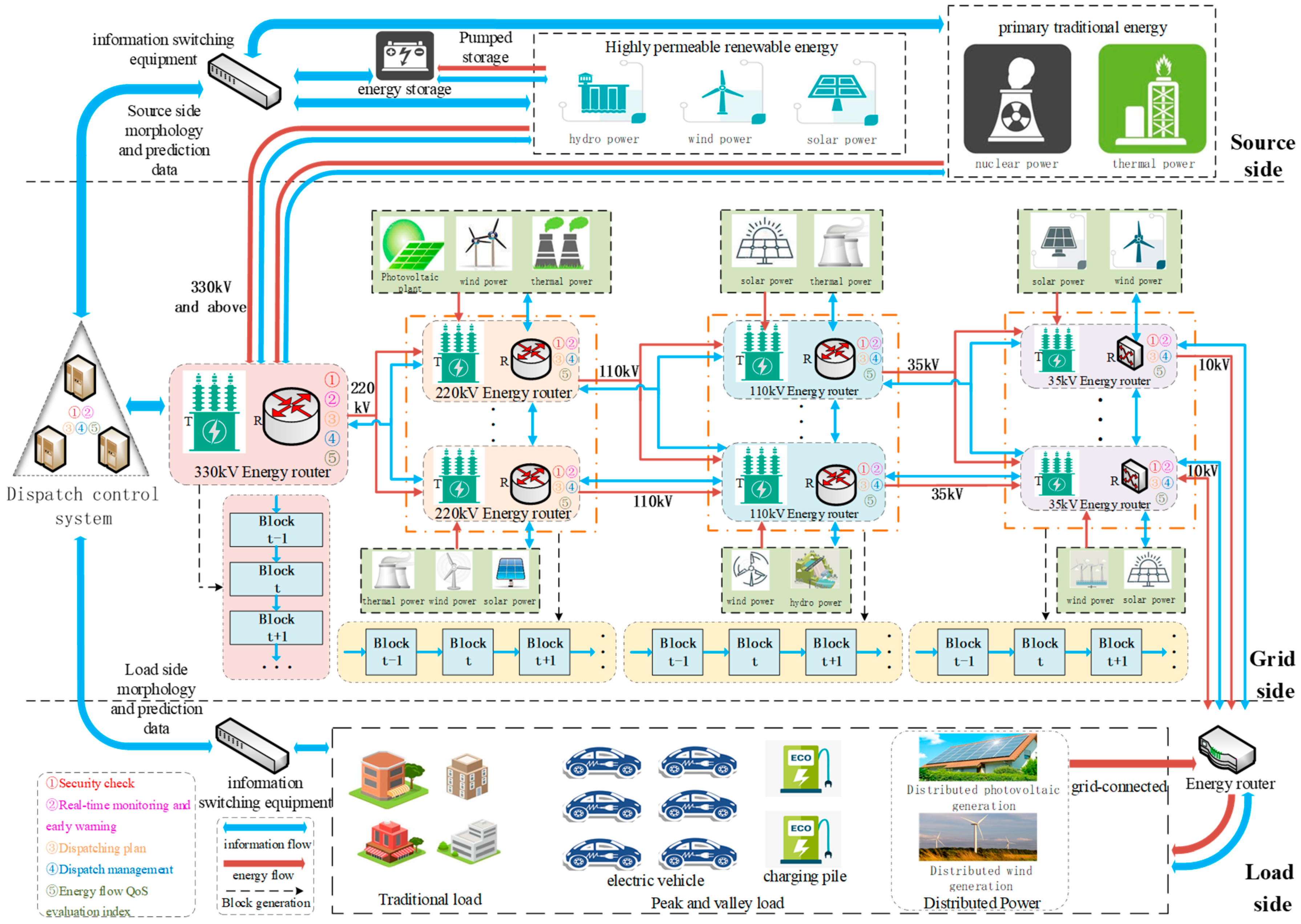
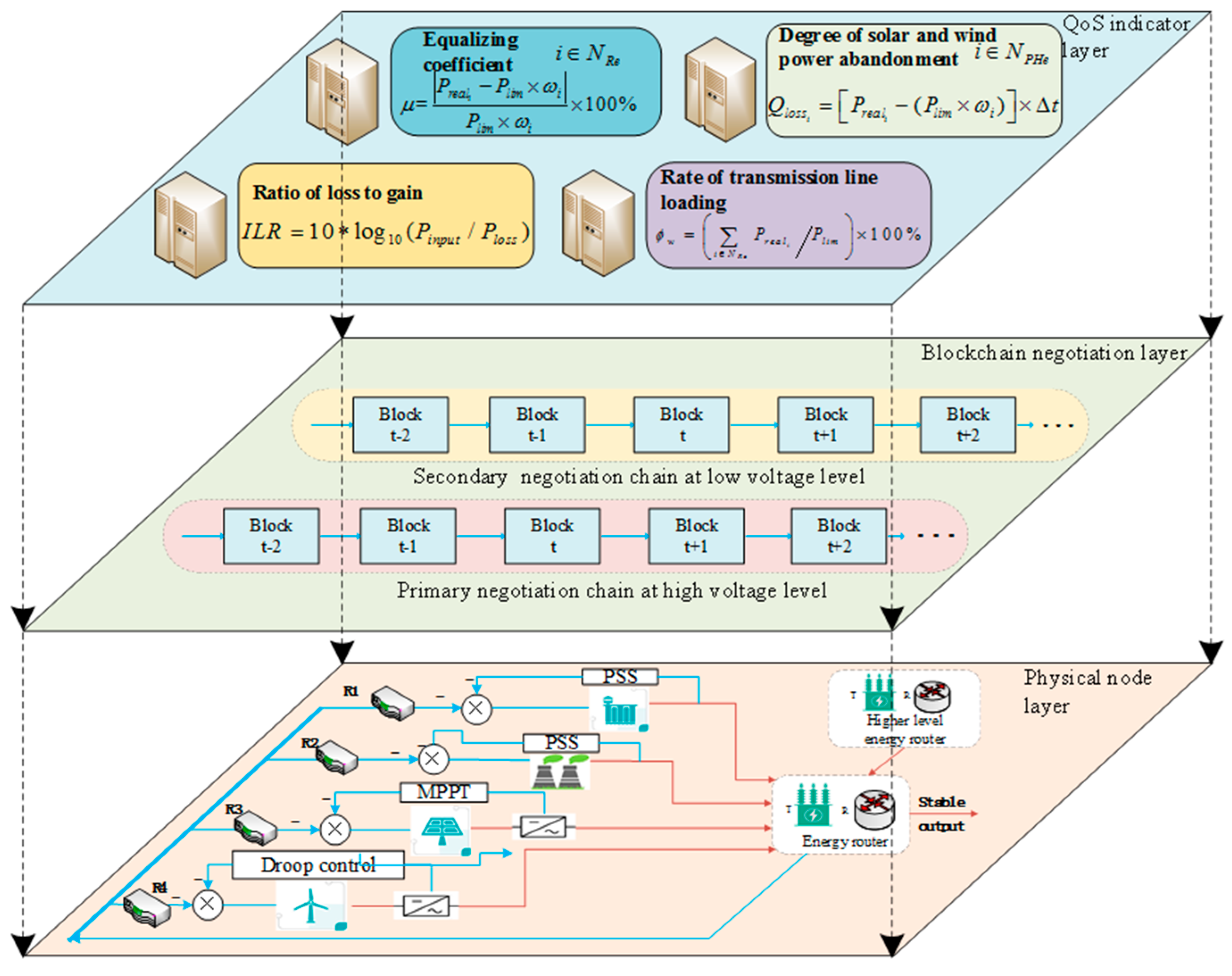
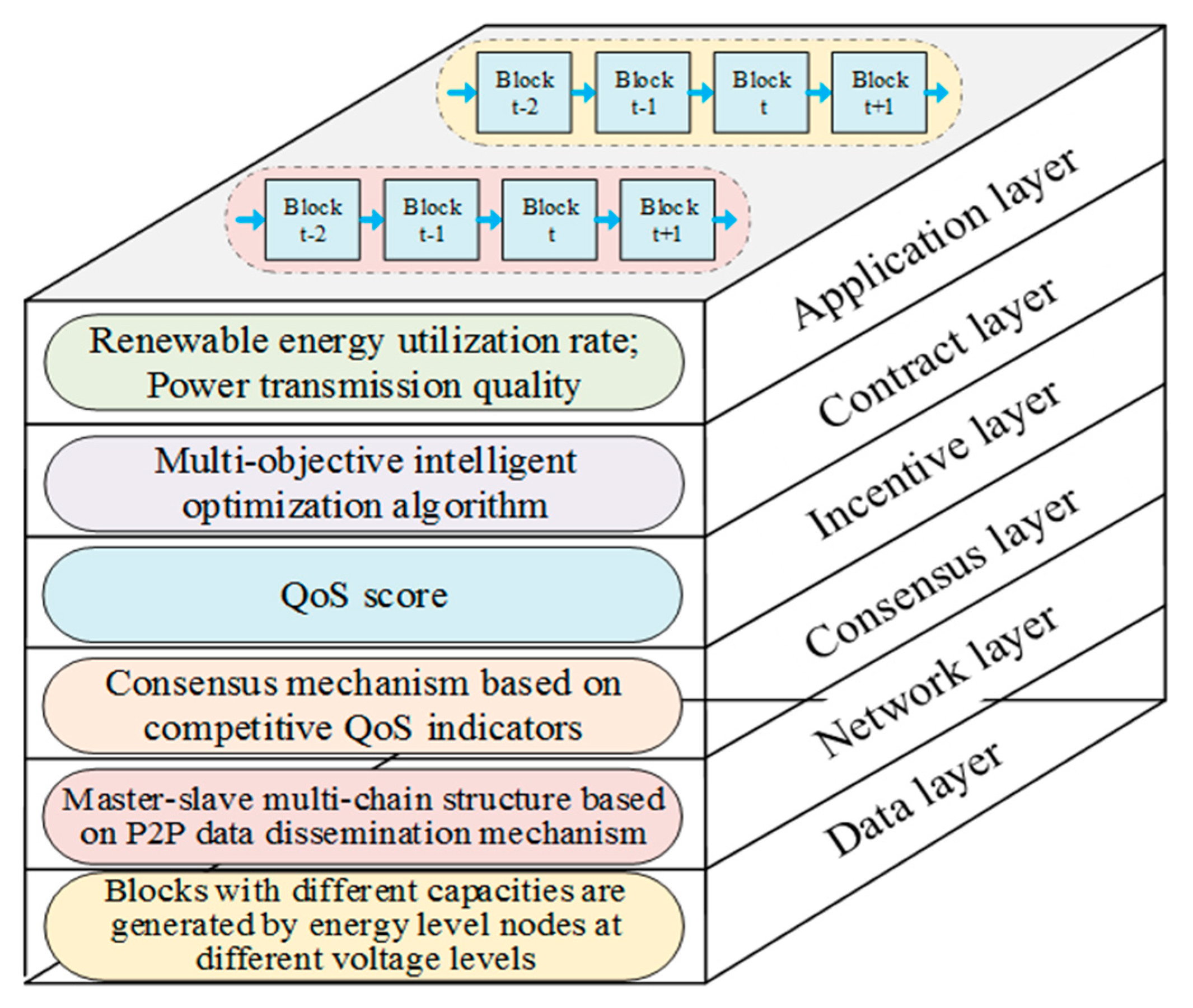
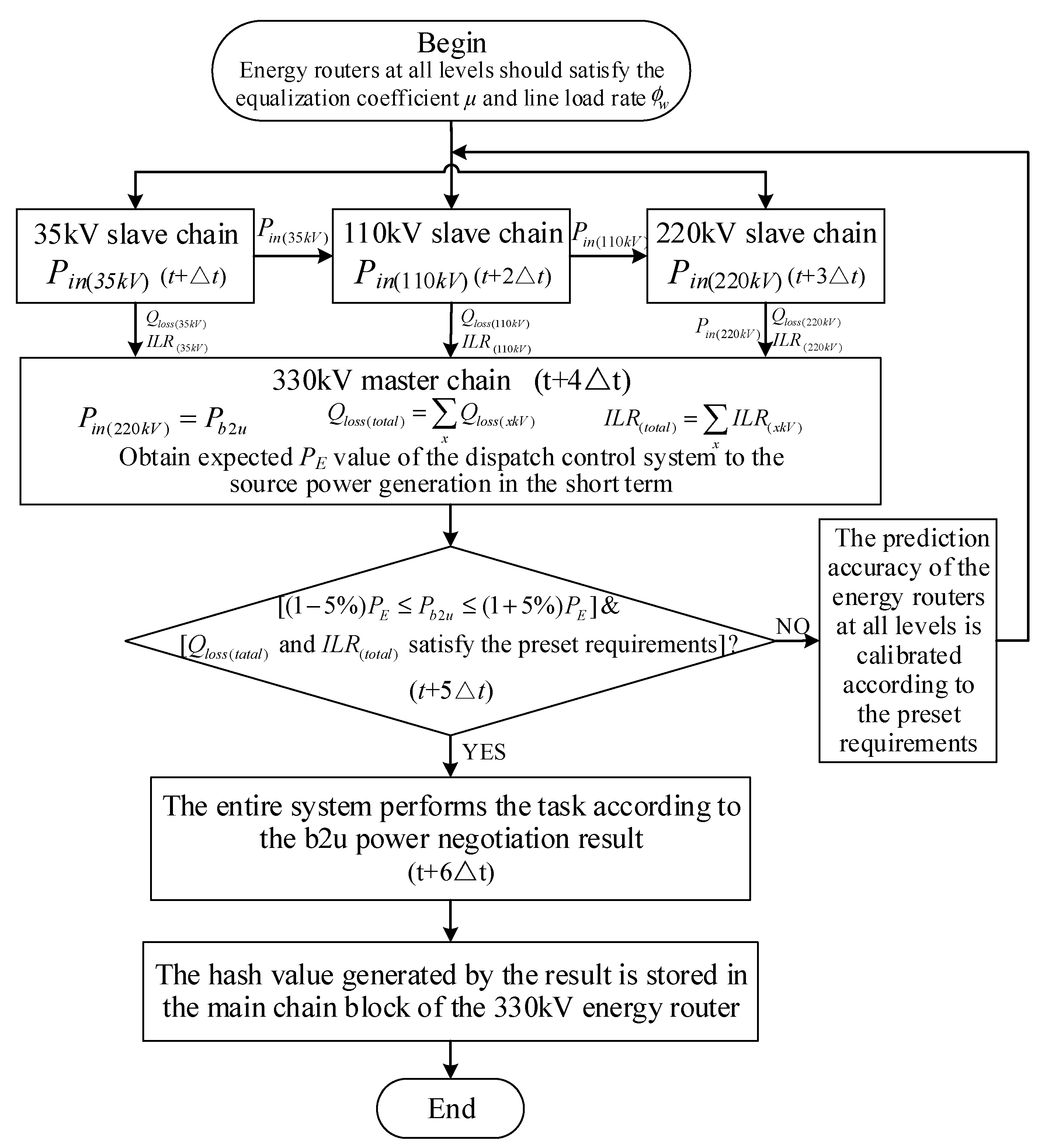
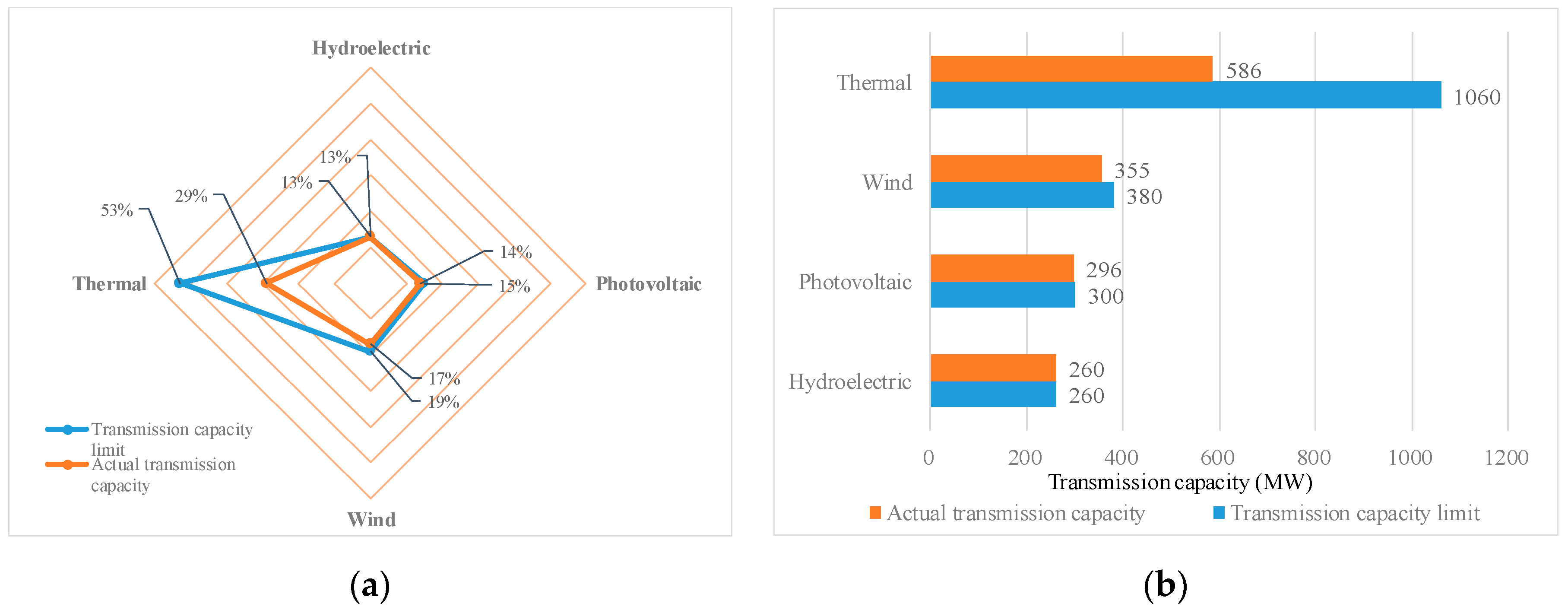
| The Scheduling Function | Corresponding Functions That Energy Router Nodes Can Implement |
|---|---|
| Real-time monitoring and early warning | Get the data result which can be checked based on self-calculation force, and monitor its safety in real-time |
| Dispatching plan | Guide the optimization of energy flow of its own node through historical generation plan and scheduling requirements |
| Security check | Independently check overload and other information |
| Dispatch management | Some functions can be negotiated and managed by energy routing nodes |
| Power Generations Types | Constraint Conditions | Objective Function | |
|---|---|---|---|
| Photovoltaic | [50%, 75%] | [10%, 20%] | 15% |
| Wind | [10%, 20%] | 19% | |
| Hydroelectric | [10%, 15%] | 13% | |
| Thermal | [25%, 55%] | 53% | |
| Power Plant | Photovoltaic | Wind | Hydroelectric | Thermal | |
|---|---|---|---|---|---|
| QoS Index | |||||
| Line load rate (φw/%) | 74.8 | ||||
| Equilibrium coefficient (μ/%) | 1.3 | 6.5 | 0.0 | 44.7 | |
| Loss degree () | 0.096 × 103 | 0.6 × 103 | 0.0 × 103 | 11.4 × 103 | |
© 2020 by the authors. Licensee MDPI, Basel, Switzerland. This article is an open access article distributed under the terms and conditions of the Creative Commons Attribution (CC BY) license (http://creativecommons.org/licenses/by/4.0/).
Share and Cite
Gong, G.; Zhang, Z.; Zhang, X.; Mahato, N.K.; Liu, L.; Su, C.; Yang, H. Electric Power System Operation Mechanism with Energy Routers Based on QoS Index under Blockchain Architecture. Energies 2020, 13, 418. https://doi.org/10.3390/en13020418
Gong G, Zhang Z, Zhang X, Mahato NK, Liu L, Su C, Yang H. Electric Power System Operation Mechanism with Energy Routers Based on QoS Index under Blockchain Architecture. Energies. 2020; 13(2):418. https://doi.org/10.3390/en13020418
Chicago/Turabian StyleGong, Gangjun, Zhening Zhang, Xinyu Zhang, Nawaraj Kumar Mahato, Lin Liu, Chang Su, and Haixia Yang. 2020. "Electric Power System Operation Mechanism with Energy Routers Based on QoS Index under Blockchain Architecture" Energies 13, no. 2: 418. https://doi.org/10.3390/en13020418
APA StyleGong, G., Zhang, Z., Zhang, X., Mahato, N. K., Liu, L., Su, C., & Yang, H. (2020). Electric Power System Operation Mechanism with Energy Routers Based on QoS Index under Blockchain Architecture. Energies, 13(2), 418. https://doi.org/10.3390/en13020418







